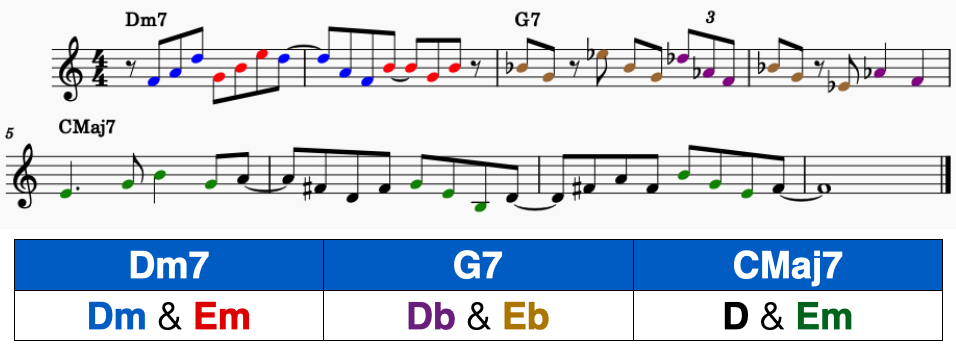Horizontal vs Vertical
As we’ve explored previously, there are two different approaches to thinking about improvisation:
- Horizontal – where we think in terms of scales; and
- Vertical – where we think in terms of chords and arpeggios.
I’ve covered vertical improvisation extensively in a previous lesson. In short, to improvise using the vertical approach you would play arpeggios (i.e., note in the chord) of each chord and connect your arpeggios using passing notes (i.e., notes not in the chord).
Extending Arpeggios
As we know, the basic chord in Jazz is a 7th chord (root-3-5-7), but we can add available tension (9-11-13) on top of the chord to give it a bit more colour. And we can do the same thing when improvising arpeggios – we can extend them by adding available tensions. For example, over a CMaj7 chord we could play:
| Notes | Degrees |
|---|---|
| root-3-5-7 | C-E-G-B |
| 3-5-7-9 | E-G-B-D |
| 5-7-9-#11 | G-B-D-F# |
| 7-9-#11-13 | B-D-F#-A |
This is a great way to add more colour and spice to your improvisation while still thinking vertically.
Triad Pairs
This brings us to triad pairs. A triad pair is a set of two triads a step apart (whole- or half-step) that do not share any notes in common. For example the below could be a triad pair that would fit nicely over a CMaj7 chord. This is because the notes in each triad are either in the CMaj7 chord or available tensions of the chord.
| Chord | Notes | Degrees from C | Colour |
|---|---|---|---|
| C | C-E-G | 1-3-5 | Blue |
| D | D-F#-A | 9-#11-13 | Red |
We can this triad pair to improvise over a CMaj7 chord by sequentially arpeggiating each triad. This create a very interesting and unique sound.

We can create sequences using each triad or just improvise freely but continue alternating between the two arpeggios (as above).
Why Triad Pairs?
Triads are harmonically strong. They are the most basic chord and are used in almost all music (or at least most Western, homophonic music). We are very comfortable with triads and very used to hearing them. For this reason, using triads as the basis of your improvisation will give you a very structured and harmonically strong solo. And alternating between two triads creates a lot more movement and interest than just using one triad (which gets boring quick).
And as we saw above triad pairs are really just a specific way of playing extended arpeggios, by breaking up a larger arpeggio into two smaller ones.
And there are LOTS of different triad pairs you can use. Each one will give your improvisation a slightly different flavour. And while typically you see triad pairs only using chord tones and available tensions, it is also acceptable to include avoid notes (as shown below in the Fm triad over Cm7). The only caveat here is that you do not want to overemphasise the avoid note as this will sound rubbish.

In Practice
In practice, you allocate a triad pair to each chord in a song, then alternate between those triads to improvise over each chord. An example of this is show below.

Have a Listen to
For some inspiration have a listen to the following sounds which make use of some great sounding triad pairs:
- Now He Sings, Now He Sobs ~ Chick Corea
- Passion Dance ~ McCoy Tyner
- Stolen Moments ~ Oliver Nelson (@4:38)